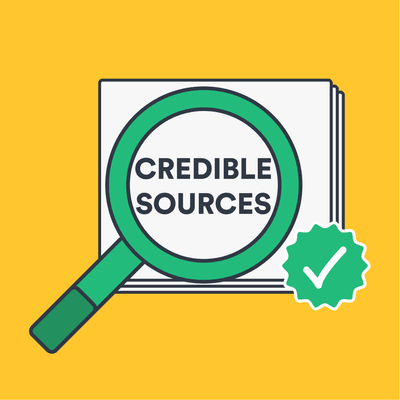How Do You Know Youre Source Is Valid
How can I find credible sources?

A source is credible when it is trustworthy. Sometimes it is hard to determine whether 'credible' sources are trustworthy or not, equally voicing an opinion or presenting faux information as fact without any credentials or proof is easy for anyone, particularly online.
Sources can often appear apparent fifty-fifty when there is little prove to support them - but think of the many pseudoscience-based manufactures that get viral on social media sites. Hither are a few points to consider when evaluating sources for credibility:
Be skeptical
But because something is presented as a fact, information technology doesn't mean that it is. Question everything, books, articles, and websites can all be unreliable sources.
Always enquiry the groundwork of whatsoever resources yous are considering using for your paper. Consider the author'due south credentials and affiliations during your search for sources, are they associated with a certain special interest grouping or another biased source of funding? Tin the author/source be biased considering of certain views and affiliations?
Evaluate what sources are cited by the author
Unless the writer is analyzing their ain data, their information came from somewhere. Beware if the author doesn't list academic sources. E'er review the type of sources listed and brand sure they stand up up to scrutiny.
Make sure the source is up-to-engagement
Nowadays, due to the speed at which technology moves, information and reliable sites go out-of-date quickly. Make certain that your source is nevertheless relevant and applicative and comes from a trustworthy author.
Check the endorsements and reviews that the source received
You can read reviews of books printed or on the websites of online book retailers. Yous tin observe reviews of larger reputable websites. Some smaller sources, similar journal articles, might non have reviews readily available, but yous can check if the authors are administrative sources in their field.
Check if the publisher of the source is reputable
Large publishers or reputable magazines and journals will thoroughly cheque the facts of the information they are distributing, which makes these sources pretty safe. This is especially truthful if the source in question comes from peer-reviewed journals or other scholarly databases.
Some of the other source-evaluation methods you can use include investigating the types of sources the author decided to apply. Apparent journal articles volition have more source brownie than personal blogs, for example. This is because journal articles are created by academics that hold the proper credentials and take to brand apply of reputable sources in gild to go through peer-review.
Pieces that are public opinion or stance pieces practice not hold up to the same standard equally academic writing. Even news articles can be biased sources; in the past few years, fake news has get widespread in online search engines. Major newspapers have fallen prey to this in contempo years.
Make sure the source does non use loaded or vague terms to back up itself
Beware of sources that utilise vague terms similar "contempo studies testify", or "many people believe", without backing up these claims with citations. Online sources are notorious for this - call back that their ultimate goal is to maximize their readership and not to produce scholarly, peer-reviewed articles.
Also, beware of buzzwords playing on the readers' emotions. Many cyberspace sources volition use misleading titles in order to draw in readers, even if they are non-credible sources.
Beware of bias
Always evaluate if the source presents clear and unbiased information, or if information technology aims at persuading you to take on a specific indicate of view. A source written from a specific point of view may notwithstanding be credible, just it can limit the coverage of a topic to a item side of a fence. Information technology's always better to brand use of sources that show both sides of the story.
Many academic papers accept to requite an overview of the other scholarly articles they used as citations.
More than information
- BYU lib guide on apparent sources
- Academy of Maryland guide on finding credible sources
Frequently Asked Questions most finding credible sources
What is a credible source?
A source is apparent when information technology is trustworthy. The exact definition changes depending from the field of research. In general, a credible source is an unbiased reference backed up past existent facts.
How do you know if a source is credible?
Here are some aspects to watch out for to make up one's mind if a source is apparent or not:
- Examine the source'due south and author's credentials and affiliations
- Evaluate what sources are cited by the author
- Make certain the source is upwardly-to-appointment
- Check the endorsements and reviews that the source received
- Cheque if the publisher of the source is reputable
How exercise you lot make certain a source is up-to-date?
Mostly in the humanities, arts, history, and literature, a source should not be older than 10 years to be considered upwardly-to-appointment and credible. Any source older than 10 years should exist avoided.
How do I know if the publisher of the source is reputable?
Usually, if the publisher is a large widely known mag or journal, so it is a apparent publisher. Examples of these publishers are Science Mag or Nature. These publishers thoroughly check the facts of the information they are distributing, which makes these sources pretty safe.
How to know if a source is biased?
When a source is biased, it aims at persuading you from a specific view. A source written from a specific indicate of view may still be credible, but it can limit the coverage of a topic to a particular side of a debate. Make sure to ever evaluate if the source presents clear and unbiased information, or if it aims at persuading you to take on a specific indicate of view.
Related Articles
Source: https://paperpile.com/g/find-credible-sources/



0 Response to "How Do You Know Youre Source Is Valid"
Postar um comentário